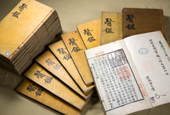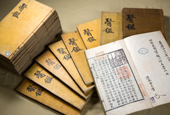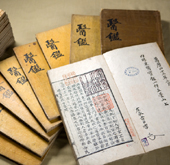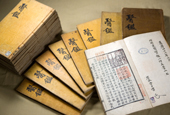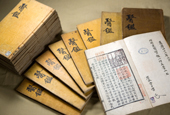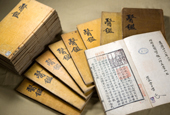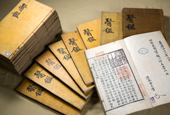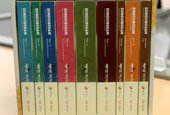The section on herbs contains all subjects on medications. In the first section, collection, preparation, decoction, pharmacology, dosage and contraindications are explained under the title of Introduction. Then, herbs are classified based on their natural origins. Since water is considered the foundation of all living things, it is listed first, with 32 subtypes. Each herb is listed with its Korean name, making it easier for the general public to understand.
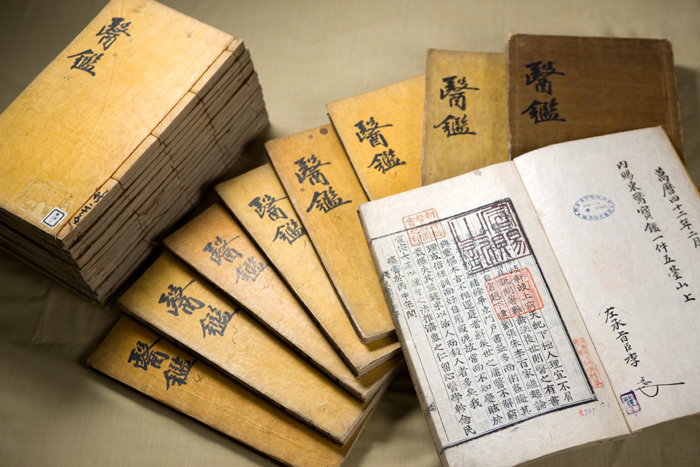
1. Introduction
This chapter is an introduction to herbal medicine. It discusses the methods of gathering, drying, and processing medicinal herbs. It also explains how prescriptions are comprised from the processed herbs. As the general properties of each herb are described in the book, we can figure out that East Asian medicine does not simply rely on experiences and in fact adheres to certain rules and know-how. Employing medicinal herbs in prescriptions requires circumspection, and so it does with deciding dosages. When more than a single type of herb is administered, certain kinds of food should be taken carefully, and using some herbs together should be avoided. These are the general rules in using herbal medicine in the chapter.
2. Water
All kinds of water first originate in Heaven, so they are listed first. In this section, 33 types of water are explained. Among these are water from the well, spring water, water from hot springs, valley water, river water, ocean water, ice, water from boiled rice, boiled water and even silkworm-cooked water. Depending on the water’s temperature, the season, location, the water’s constituents, flow, and processing, different efficacies will result.
3 Soil
Some types of soil have medicinal efficacy. Clay from the kiln, clay scraped from the walls and sand underneath the well are all good sources of medicine. In this section, the book lists 18 types of soil. Since all things derive from the earth, the Dongui Bogam ranks the soils second to water.
4 Grains
Grains sustain the lives of humans living between Heaven and Earth. Grains absorb the energy from the earth; thus, their characters are neutral and bland. However, they also provide sweetness at the same time. Grains tonify the body and pass through the digestive system with ease, so they can be enjoyed in the long term. Grains are especially beneficial to humans. In this section, the Dongui Bogam lists 107 types of grains. Included are popular grains such as rice, millet, barnyard millet, poppy seed, as well as derivatives of yeast, alcohol, bean paste, vinegar, wheat-gluten and tofu.
5 Human Ingredients
Various by-products of the human body are precious treatment substances, for example, urine from children, the hygienic band of a woman and the placenta after delivery.
6 Avian
The Dongui Bogam cites 107 kinds of birds for medicinal use. Most of the birds we see are applicable. Chicken, duck, goose, sparrow, swallow, pigeon, magpie, crow, cuckoo, woodpecker, crane, swan, Korean crow-tit, white stork, owl, bat, seagull and wild goose are all superb medicinal products. The flesh of some birds may be used, as well as such parts as the head, eye, egg, feces, oil and beak. There are three general classifications of birds in the book: birds to tonify the body, the medicinal usage of birds' eggs and feces, and usage for treatments.
7 Land Animals
Land animals are valuable sources of treating various disorders. A total of 236 types of animals are listed in the Dongui Bogam. Dragon bone, elephant, deer, cow, bear, horse, ocean otter, roe deer, ram, goat, water buffalo, tiger, leopard, wildcat, cat, rabbit, pig, flying squirrel and weasel are some of the animals listed in the book. Among these, dragon bone, elephant tusk, water buffalo, monkey and camel are imported. Not only is the flesh of animals used as medicine, but so too are their organs, skin, antlers, secretions and excretions.
8 Sea Creatures
According to the Dongui Bogam, 27 species, totaling 53 types of fish are used for medicinal purposes, including both freshwater and salt-water fish, in addition to squid, cuttlefish and octopus. Some of the 27 species are carp, goldfish, squid, snakefish, eel, shark, mandarin fish, codfish, octopus, cuttlefish, trout, salmon, whitebait, mudfish, sandfish and mackerel. The book goes on to specifically list certain parts of the fish that may be used, such as the flesh, bone, marrow, blood, intestines, scales, eyes, teeth and fins. Some of these must be made into a soup, boiled or eaten raw.
9. Insects
The section on insects not only covers insects, but also anything other than birds and mammals. Besides the modern classification of insects, other creatures including mollusks, reptiles, amphibians, crustaceans and shellfish are listed in this section. A total of 95 types are included. These are further classified into 40 sub-types, including bee, oyster, turtle, terrapin, abalone, crab, crawfish, praying mantis, cicada, maggot, silkworm, locust, snail, horsefly, clam, seahorse, toad, frog, shrimp, mud snail, conch, scorpion, anteater, dragonfly, firefly, sow bug, moth, lice, tadpole and so forth. Whether it be the skin, legs, other parts of the animal or its excretions, it is dependent upon the type of animal to determine what may be used as medicine.
10. Fruits
The Dongui Bogam covers both medicinal fruits and their trees in the same section. Quite a few fruits and trees are used as medicine. Most of the familiar fruits are actually used for medicinal purposes. Some of the common ones are lotus, water chestnut, tangerine and orange, bitter orange peel, Chinese quince, loquat, lichee, persimmon, peach, apricot, pomegranate, pear, crab apple, plum, walnut, pine nut, hazelnut, ginkgo, hawthorn berry and so forth. Among these, orange, coconut, sugar cane, longan, fig and a few more are from tropical or subtropical regions that are imported through China. The skin, kernel, stalk or seeds of the fruits are used. This section includes 91 types of fruits and their derivatives as medicinal substances.
11. Vegetables
The Dongui Bogam lists greens and wild vegetables used as herbs in this section. Greens harvested in the field, wild vegetables, mushrooms collected in the mountain, and prairie and seaweeds from the ocean are all included in this group. Some of the listed items include taro, marshmallow, chard, spinach, hibiscus, turnip, radish, Chinese cabbage, mustard, lettuce, ginger, dried ginger, green onion, garlic, leek, scallion, water pepper, water mugwort, dropwort, tree mushroom, shiitake mushroom, seaweed, kelp, laver and glue plant. Various parts of the vegetables are used for herbs, including the root, leaf, fruit and so forth. There are 122 listings in the section.
12. Plants
Plants account for the largest portion of medicinal materials. In the Dongui Bogam, 198 types of plants are introduced. Medicinal plants that are frequently found in the wild habitats of Korea such as Mugwort, Xanthium Fruit and Arrowroot are listed in the book. In any species of plant, all parts may be used for medicine including its roots, stems, leaves and flowers. The characteristics, properties and effects of each plant are also discussed here.
13. Trees
In this section, the book deals with trees used as medicine. Fruiting woods are covered in another section under "fruit," but the rest are mentioned here. There are 156 types of tree-derived herbs. Herbs in this section are described in the fashion of materia medica. Fruit, stem, leaf, root, resin and other parts of trees are used as medicine.
14. Jades
In the Dongui Bogam, jade and other precious stones are listed as usable medicinal substances. These include jade powder, glass, coral and pearls. All except pearls are imported from China.
15. Minerals and Stones
The Dongui Bogam lists 55 types of stones for medicinal use. Some of the important substances are cinnabar, gypsum, actionlitum, glauberite, lithargyrum, arsenic, haematitum and so forth. Others such as alumen, magnet and salt were used not only in alchemy but also as medicine. Some of more peculiar substances that the book considers a medicine include lime, stone from patients afflicted by Lin Syndrome, petrified crab, aged tile, brick and ceramic fragments.
16. Metals
Gold powder, silver powder, mercury, lead, steel, copper, mirror and even nails can be used as herbs. The Dongui Bogam lists 33 types of minerals and metals that may be used for medicinal purposes. Gold, silver, mercury, and its composites, lead, copper and steel are covered in depth.
[ Acupuncture and Moxibustion ]
The chapter on acupuncture and moxibustion abridges complicated theories and focuses on practical information for actual clinical usage. The contents include types of needles, needling techniques, moxibustion techniques, point location, tonification and sedation, and the passage of the 12 meridians and extraordinary meridians, which are essential in the practice of acupuncture.
A meridian is the pathway where qi and blood travel along the superficial region of the body. Meridians are divided into two attributes: one running vertically throughout the body and a network of channels diverging from the meridians and covering the body like a web. The 12 meridians, 12 channel divergences, eight extraordinary vessels, 15 network vessels, 12 channel sinews and 12 cutaneous regions are all part of the meridian system.
An acupoint is the location (hole) where a needle penetrates the skin. Thus, the acupoint is like a hole in the path of energy flow. It is the gathering place of the qi and the blood of organs and meridians, and thus changes in the organs can be detected by analyzing the acupoint. Giving stimulation by inserting the needle, performing moxibustion or massaging the area can treat disorders of the body. It is important to know the exact location of acupoints for acupuncture and moxibustion treatments.
Regarding moxibustion, the Dongui Bogam covers the use of mugwort, making the moxa stick, igniting the moxa, the duration, placement and principles of the moxa and the use of moxibustion with several other herbs.
A practitioner must pay attention when administering acupuncture and moxibustion. According to the book, acupuncture and moxibustion are not generally administered at the same time, and, depending on the individual constitution of the patient, may not be recommended treatments at all. The practitioner should examine the patient thoroughly before initiating such treatment and needs to manage the prognosis after proceeding. Other important factors include the proper areas and days for the treatment, as well as the principles of tonification and sedation.

1. Introduction
This chapter is an introduction to herbal medicine. It discusses the methods of gathering, drying, and processing medicinal herbs. It also explains how prescriptions are comprised from the processed herbs. As the general properties of each herb are described in the book, we can figure out that East Asian medicine does not simply rely on experiences and in fact adheres to certain rules and know-how. Employing medicinal herbs in prescriptions requires circumspection, and so it does with deciding dosages. When more than a single type of herb is administered, certain kinds of food should be taken carefully, and using some herbs together should be avoided. These are the general rules in using herbal medicine in the chapter.
2. Water
All kinds of water first originate in Heaven, so they are listed first. In this section, 33 types of water are explained. Among these are water from the well, spring water, water from hot springs, valley water, river water, ocean water, ice, water from boiled rice, boiled water and even silkworm-cooked water. Depending on the water’s temperature, the season, location, the water’s constituents, flow, and processing, different efficacies will result.
3 Soil
Some types of soil have medicinal efficacy. Clay from the kiln, clay scraped from the walls and sand underneath the well are all good sources of medicine. In this section, the book lists 18 types of soil. Since all things derive from the earth, the Dongui Bogam ranks the soils second to water.
4 Grains
Grains sustain the lives of humans living between Heaven and Earth. Grains absorb the energy from the earth; thus, their characters are neutral and bland. However, they also provide sweetness at the same time. Grains tonify the body and pass through the digestive system with ease, so they can be enjoyed in the long term. Grains are especially beneficial to humans. In this section, the Dongui Bogam lists 107 types of grains. Included are popular grains such as rice, millet, barnyard millet, poppy seed, as well as derivatives of yeast, alcohol, bean paste, vinegar, wheat-gluten and tofu.
5 Human Ingredients
Various by-products of the human body are precious treatment substances, for example, urine from children, the hygienic band of a woman and the placenta after delivery.
6 Avian
The Dongui Bogam cites 107 kinds of birds for medicinal use. Most of the birds we see are applicable. Chicken, duck, goose, sparrow, swallow, pigeon, magpie, crow, cuckoo, woodpecker, crane, swan, Korean crow-tit, white stork, owl, bat, seagull and wild goose are all superb medicinal products. The flesh of some birds may be used, as well as such parts as the head, eye, egg, feces, oil and beak. There are three general classifications of birds in the book: birds to tonify the body, the medicinal usage of birds' eggs and feces, and usage for treatments.
7 Land Animals
Land animals are valuable sources of treating various disorders. A total of 236 types of animals are listed in the Dongui Bogam. Dragon bone, elephant, deer, cow, bear, horse, ocean otter, roe deer, ram, goat, water buffalo, tiger, leopard, wildcat, cat, rabbit, pig, flying squirrel and weasel are some of the animals listed in the book. Among these, dragon bone, elephant tusk, water buffalo, monkey and camel are imported. Not only is the flesh of animals used as medicine, but so too are their organs, skin, antlers, secretions and excretions.
8 Sea Creatures
According to the Dongui Bogam, 27 species, totaling 53 types of fish are used for medicinal purposes, including both freshwater and salt-water fish, in addition to squid, cuttlefish and octopus. Some of the 27 species are carp, goldfish, squid, snakefish, eel, shark, mandarin fish, codfish, octopus, cuttlefish, trout, salmon, whitebait, mudfish, sandfish and mackerel. The book goes on to specifically list certain parts of the fish that may be used, such as the flesh, bone, marrow, blood, intestines, scales, eyes, teeth and fins. Some of these must be made into a soup, boiled or eaten raw.
9. Insects
The section on insects not only covers insects, but also anything other than birds and mammals. Besides the modern classification of insects, other creatures including mollusks, reptiles, amphibians, crustaceans and shellfish are listed in this section. A total of 95 types are included. These are further classified into 40 sub-types, including bee, oyster, turtle, terrapin, abalone, crab, crawfish, praying mantis, cicada, maggot, silkworm, locust, snail, horsefly, clam, seahorse, toad, frog, shrimp, mud snail, conch, scorpion, anteater, dragonfly, firefly, sow bug, moth, lice, tadpole and so forth. Whether it be the skin, legs, other parts of the animal or its excretions, it is dependent upon the type of animal to determine what may be used as medicine.
10. Fruits
The Dongui Bogam covers both medicinal fruits and their trees in the same section. Quite a few fruits and trees are used as medicine. Most of the familiar fruits are actually used for medicinal purposes. Some of the common ones are lotus, water chestnut, tangerine and orange, bitter orange peel, Chinese quince, loquat, lichee, persimmon, peach, apricot, pomegranate, pear, crab apple, plum, walnut, pine nut, hazelnut, ginkgo, hawthorn berry and so forth. Among these, orange, coconut, sugar cane, longan, fig and a few more are from tropical or subtropical regions that are imported through China. The skin, kernel, stalk or seeds of the fruits are used. This section includes 91 types of fruits and their derivatives as medicinal substances.
11. Vegetables
The Dongui Bogam lists greens and wild vegetables used as herbs in this section. Greens harvested in the field, wild vegetables, mushrooms collected in the mountain, and prairie and seaweeds from the ocean are all included in this group. Some of the listed items include taro, marshmallow, chard, spinach, hibiscus, turnip, radish, Chinese cabbage, mustard, lettuce, ginger, dried ginger, green onion, garlic, leek, scallion, water pepper, water mugwort, dropwort, tree mushroom, shiitake mushroom, seaweed, kelp, laver and glue plant. Various parts of the vegetables are used for herbs, including the root, leaf, fruit and so forth. There are 122 listings in the section.
12. Plants
Plants account for the largest portion of medicinal materials. In the Dongui Bogam, 198 types of plants are introduced. Medicinal plants that are frequently found in the wild habitats of Korea such as Mugwort, Xanthium Fruit and Arrowroot are listed in the book. In any species of plant, all parts may be used for medicine including its roots, stems, leaves and flowers. The characteristics, properties and effects of each plant are also discussed here.
13. Trees
In this section, the book deals with trees used as medicine. Fruiting woods are covered in another section under "fruit," but the rest are mentioned here. There are 156 types of tree-derived herbs. Herbs in this section are described in the fashion of materia medica. Fruit, stem, leaf, root, resin and other parts of trees are used as medicine.
14. Jades
In the Dongui Bogam, jade and other precious stones are listed as usable medicinal substances. These include jade powder, glass, coral and pearls. All except pearls are imported from China.
15. Minerals and Stones
The Dongui Bogam lists 55 types of stones for medicinal use. Some of the important substances are cinnabar, gypsum, actionlitum, glauberite, lithargyrum, arsenic, haematitum and so forth. Others such as alumen, magnet and salt were used not only in alchemy but also as medicine. Some of more peculiar substances that the book considers a medicine include lime, stone from patients afflicted by Lin Syndrome, petrified crab, aged tile, brick and ceramic fragments.
16. Metals
Gold powder, silver powder, mercury, lead, steel, copper, mirror and even nails can be used as herbs. The Dongui Bogam lists 33 types of minerals and metals that may be used for medicinal purposes. Gold, silver, mercury, and its composites, lead, copper and steel are covered in depth.
[ Acupuncture and Moxibustion ]
The chapter on acupuncture and moxibustion abridges complicated theories and focuses on practical information for actual clinical usage. The contents include types of needles, needling techniques, moxibustion techniques, point location, tonification and sedation, and the passage of the 12 meridians and extraordinary meridians, which are essential in the practice of acupuncture.
A meridian is the pathway where qi and blood travel along the superficial region of the body. Meridians are divided into two attributes: one running vertically throughout the body and a network of channels diverging from the meridians and covering the body like a web. The 12 meridians, 12 channel divergences, eight extraordinary vessels, 15 network vessels, 12 channel sinews and 12 cutaneous regions are all part of the meridian system.
An acupoint is the location (hole) where a needle penetrates the skin. Thus, the acupoint is like a hole in the path of energy flow. It is the gathering place of the qi and the blood of organs and meridians, and thus changes in the organs can be detected by analyzing the acupoint. Giving stimulation by inserting the needle, performing moxibustion or massaging the area can treat disorders of the body. It is important to know the exact location of acupoints for acupuncture and moxibustion treatments.
Regarding moxibustion, the Dongui Bogam covers the use of mugwort, making the moxa stick, igniting the moxa, the duration, placement and principles of the moxa and the use of moxibustion with several other herbs.
A practitioner must pay attention when administering acupuncture and moxibustion. According to the book, acupuncture and moxibustion are not generally administered at the same time, and, depending on the individual constitution of the patient, may not be recommended treatments at all. The practitioner should examine the patient thoroughly before initiating such treatment and needs to manage the prognosis after proceeding. Other important factors include the proper areas and days for the treatment, as well as the principles of tonification and sedation.

